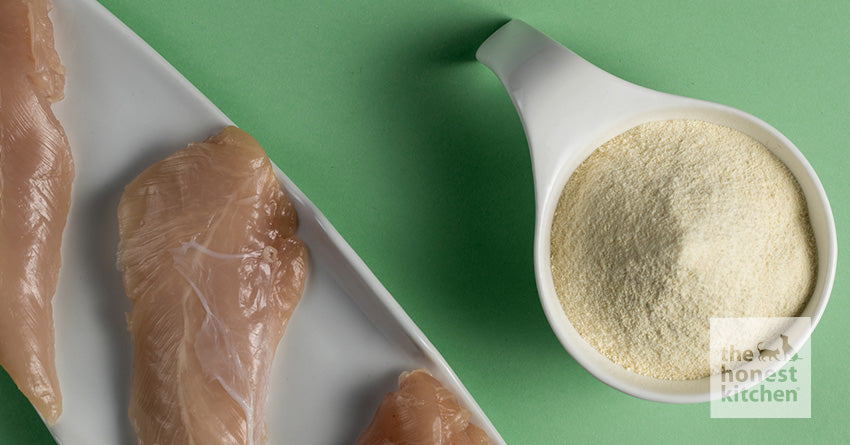If you've ever looked closely at the ingredients on pet food labels, you've almost certainly seen "chicken meal" listed as a main ingredient in many commercial pet foods. In fact, according to a 2020 report, pet food manufacturers use about 1.5 million metric tons of rendered proteins (including meat meal) each year.
Specifically, chicken meal refers to any combination of chicken flesh, skin, and bone — ground down, melted, and then dried at high temperatures to make a powder. The result is a protein-rich meal that can be incorporated into kibble for dogs and cats.
But what parts of the animal does chicken meal contain, why is it such a common pet food ingredient, and is it any good for your beloved pet?
Why Is Chicken Meal Commonly Included in Pet Food?
There are a few reasons why chicken meal is such a common ingredient in major pet food brands. For starters, the rendering process used to create chicken meal (and other types of meat meal) results in a finished product high in protein. Because AAFCO feeding guidelines recommend protein as the most abundant ingredient in pet food, chicken meal is a convenient way to meet these requirements.
Likewise, because chicken meal is rendered as a dry powder, it's easy to store, ship, and incorporate into dry or wet food. It can sit for days or weeks without spoiling before being used in pet food, making it a more stable ingredient than fresh chicken. And when it comes to cost-effective protein sources for pets, meat meal is cheap and readily available.
What Does Chicken Meal Consist Of?
This low cost and high convenience does come with some sacrifices. Chicken meal is typically made with feed grade chicken (meats that aren't human-edible), which can include "4D meats" from animals that are dying, deceased, disabled*, or diseased.
While there's no guarantee that the meat meal in your pet's food comes from 4D meats, there's also no guarantee that it doesn't. This sense of mystery isn't something many pet owners appreciate when shopping for pet food. Instead, they prefer to know exactly what they're feeding their pets.
*Disabled is an industry term that refers to an animal's sudden loss of ability to walk properly. This is often a symptom of an illness like mad cow disease, which makes it unfit for the human food supply chain.
Is Chicken Meal Good for Pets?
Ultimately, chicken meal and other meat meals serve the functional purpose of providing an affordable and convenient protein source for pets. If you're trying to create a pet food formula that is nutritionally dense, chicken meal makes this easy with its widespread availability and low cost.
However, while meat meals may not necessarily be bad for pets, there are some nuances to keep in mind. Consider, for example, what happens to nutrients in foods when they are heated to extremely high temperatures. Much of the nutritional quality is lost in this cooking process, which is no different in highly processed chicken meal.
When you choose a pet food made with real, human grade chicken as its first ingredient, your pet enjoys the same high protein content with a more complete and unaltered nutritional profile.
Pros and Cons of Foods With Chicken Meal
Pros:
- More budget-friendly
- Packed with protein
Cons:
- Quality of protein sourcing may be low (not all chicken meat is of the same quality)
- Potential for inconsistencies in safety/quality standards among pet food companies
- May contain 4D meats that aren't fit for human consumption
- Less nutritionally complete than raw chicken due to the high heat rendering process
How Is Chicken Meal Made?
AAFCO defines chicken/poultry meal as, "The dry rendered product from a combination of clean flesh and skin with or without accompanying bone, derived from the parts or whole carcasses of poultry or a combination thereof, exclusive of feathers, heads, feet, and entrails."
When chicken meal is made, the parts of the chicken are ground down and rendered at extremely high temperatures to remove excess moisture and fat while killing off potentially harmful bacteria. The final product is a fine powder that can be used as a concentrated protein and mineral ingredient in pet food.
Chicken Meal vs. Human Grade Chicken
Chicken meal (and other meat meals) isn't necessarily harmful to your pet, but there are more nutritious alternatives — like human grade real chicken.
If you want to give your pet the same quality chicken you'd find at your local grocery store, then a pet food with human grade chicken as its first ingredient is a better option. Human grade pet food is made with quality ingredients that are human-edible at every stage of the production process.
Human grade chicken, when used in pet food, is more thoughtfully sourced and provides higher quality nutrition than chicken meal. That's because fresh chicken is gently dehydrated at lower temperatures, resulting in 70% water content, 18% protein, and 5% fat. Chicken meal, with its high-temperature rendering, is more concentrated with 65% protein, 12% fat, and just 10% water.
While chicken meal may offer higher levels of protein than fresh chicken, the important thing to remember is that not all protein is the same. Digestible protein is what matters most — and, unfortunately, chicken meal simply doesn't contain the highly digestible proteins and amino acids that dogs and cats need to support their health and well-being. If you want your pet to get the most out of their food, they're better off with fresh, real chicken as the main ingredient.
When you feed your pet food made with human grade ingredients and processed in a human grade kitchen, you can feel confident knowing that you're only serving your pet the same quality ingredients that you'd enjoy yourself. Likewise, you can rest assured that your pet will get their recommended protein source directly from fresh, natural ingredients (like cage free chicken).
Is Chicken Meal the Same as Chicken By-Product?
As you explore pet food options, you'll likely notice terms similar to chicken meal, such as "chicken by-product."
It's important to understand that chicken meal and chicken by-products are not the same thing. The main difference is that chicken by-product refers to non-rendered, clean parts of slaughtered poultry that may include heads, feet, undeveloped eggs, and entrails from the animal. By-product also isn't rendered in the same way as chicken meal, which allows it to retain more nutritional content (but also means it's not as dense in protein).
What about "chicken by-product meal"? This is what you have when the above ingredients (including heads, feet, organs, and undeveloped eggs) are ground down and rendered at a high temperature to create a dry, dense powder. This powder is then incorporated into dry dog food and dry cat food.
The terminology can get a bit confusing, especially after you've been studying pet food ingredient labels for a while. Ultimately, while chicken meal and chicken by-product have some key differences, neither provide the best nutrition source for our pets.
Fulfill Your Pet's Nutritional Needs With Human Grade Food From The Honest Kitchen
If you've been feeding your pet food with chicken meal and never thought anything of it until now, there's no reason to beat yourself up about it. At the end of the day, chicken meal does provide your pet with protein they need to build muscle and carry out other essential functions.
However, if you're ready to step up your pet's nutrition game and serve them the same quality ingredients you'd want in your own food, a human grade option from The Honest Kitchen is a great place to start.
We offer a wide range of dry cat food and dog food, gently dehydrated pet food, wet food, treats, and toppers that feature fresh meat at the top of the ingredient list. Our sustainable foods never contain meat meals, by-products, additives, or artificial ingredients — just the high quality and essential nutrients your pet needs to thrive.
Shop our selection of nutritious, human grade pet food today and treat your pet to the best!

